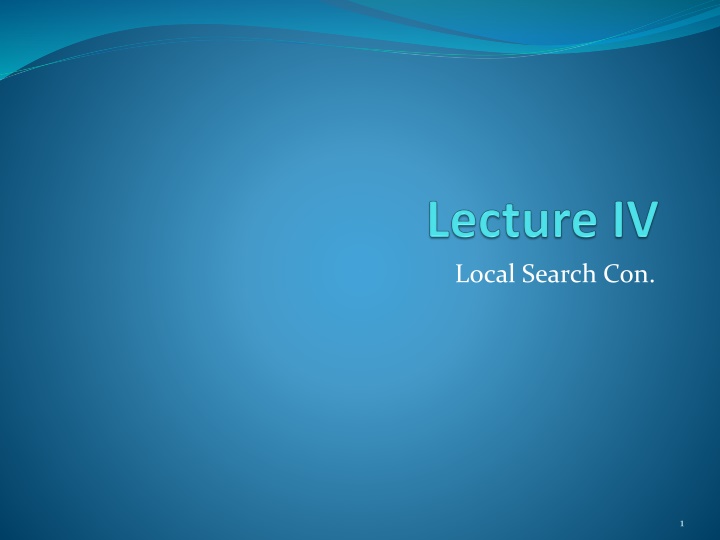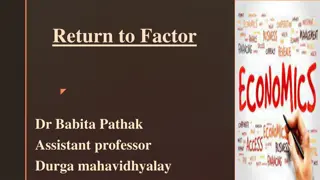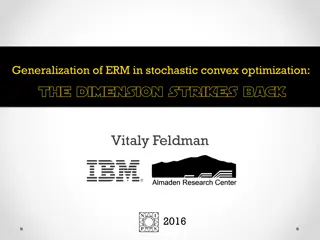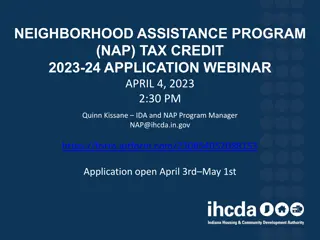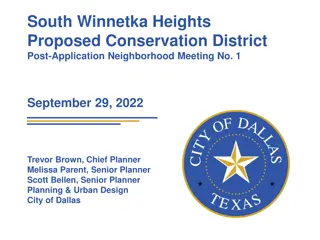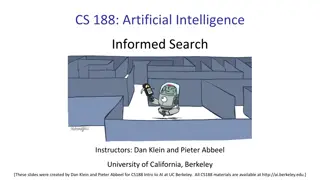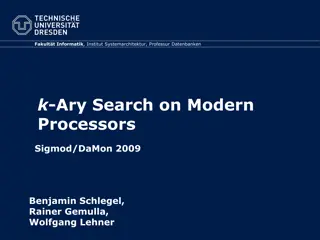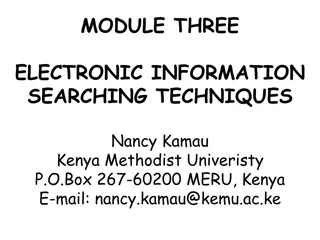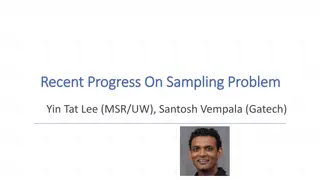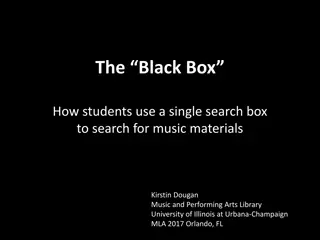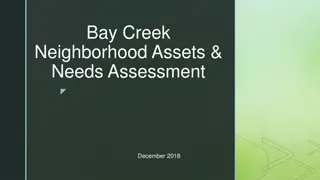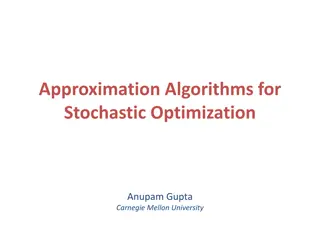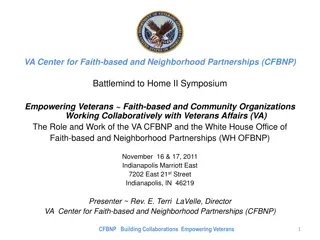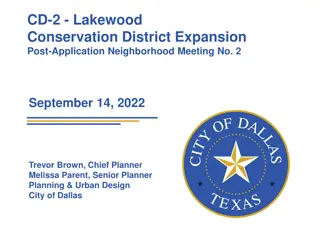Variable Neighborhood Search Techniques in Optimization
Variable Neighborhood Search (VNS) is a powerful optimization technique that involves changing the neighborhood during the search process. This approach is based on the observation that a local minimum in one neighborhood structure may not be globally optimal. By exploring different neighborhood structures, VNS aims to find better solutions and escape local minima. The method allows for the generation of various neighborhood structures and can be applied to a wide range of optimization problems. Techniques such as Variable Neighborhood Descent and Variable Neighborhood Decomposition Search enhance the efficiency of the search process by utilizing different neighborhood strategies. With VNS, solutions can be improved iteratively by incorporating various neighborhood structures, ultimately leading to enhanced solution quality and speed.
Download Presentation

Please find below an Image/Link to download the presentation.
The content on the website is provided AS IS for your information and personal use only. It may not be sold, licensed, or shared on other websites without obtaining consent from the author.If you encounter any issues during the download, it is possible that the publisher has removed the file from their server.
You are allowed to download the files provided on this website for personal or commercial use, subject to the condition that they are used lawfully. All files are the property of their respective owners.
The content on the website is provided AS IS for your information and personal use only. It may not be sold, licensed, or shared on other websites without obtaining consent from the author.
E N D
Presentation Transcript
Outline Variable neighbourhoods Variable neighbourhood decent Variable neighbourhood search Guided local search GRASP Large neighbourhood search Tabu Search Simulated annealing algorithm 2
Variable neighborhood Search (VNS) Based on the following central observations A local minimum w.r.t. one neighborhood structure is not necessarily locally minimal w.r.t. another neighborhood structure A global minimum is locally optimal w.r.t. all neighborhood structures For many problems, local minima with respect to one or several neighborhoods are relatively close to each other 3
Variable Neighborhood Search Basic principle: change the neighborhood during the search Variations: Variable Neighborhood Descent Basic Variable Neighborhood Search Reduced Variable Neighborhood Search Variable Neighborhood Decomposition Search 5
Variable Neighborhood Search The first task is to generate the different neighborhood structures For many problems different neighborhood structures already exists E.g., for the VRP: 2-Opt, Cross, Swap, Exchange, Find neighborhoods that depend on some parameter k-Opt (k=2,3, ) Flip-neighborhoods can be extended to double-flip, triple- flip, etc Some neighborhoods are associated with distance measures: can increase the distance 6
Variable Neighborhood Descent The final solution is locally optimal with respect to all neighborhoods, N1, N2, , Nk-max First Improvement could be used instead of Best Improvement Typically, neighborhoods are ordered from smallest to largest If Local Search Algorithms can be treated as Black-Box procedures: Sort the procedures Apply them in the given order Possibly reiterate starting the first one Advantage: solution quality and speed 8
Basic Variable Neighborhood Search Use neighborhood structures N1, N2, , Nk-max Standard ( Best Improvement ) Local Search is applied in N1 The other neighborhoods are explored only randomly Exploration of the other neighborhoods are perturbations as in ILS Perturbation is systematically varied 9
Variations of Basic VNS The order of the neighborhoods Forward VNS: start with k=1 and increase Backward VNS: start with k=kmaxand decrease Extended version: Parameters kminand kstep Set k = kmin, and increase k by kstepif no improvement Accepting worse solutions With some probability Skewed VNS: Accept if f(s*)- d(s, s*) < f(s) d(s, s*) measures the distance between the solutions 12
Final Notes on VNS Other variations exists Reduced VNS: same as Basic VNS, but no Local Search procedure Can be fast Variable Neighborhood Decomposition Search Fix some components of the solution, and perform Local Search on the remaining free components 13
Final Notes on VNS ILS and VNS are based on different underlying philosophies ILS: Perturb and do Local Search VNS: Exploit different neighborhoods ILS and VNS are also similar in many respects ILS can be more flexible w.r.t. the optimization of the interaction between modules VNS gives place to approaches such as VND for obtaining more powerful Local Search approaches 14
Conclusions about ILS and VNS Based on simple principles Easy to understand Basic versions are easy to implement Robust Highly effective 15
Guided Local Search A general strategy, metaheuristic, used to guide a neighborhood search Tries to overcome local optima by removing them: Changes the topography of the search space Uses an extended move evaluation function Original objective function + penalties Focuses on promising parts of the search space 17
Features of a Solution GLS assumes that we can find some features of a solution that we can penalize What is a feature ? Something that is characteristic for the solution Something that might be different in another solution Problem dependent Examples: TSP: whether city A follows immediately after city B in the tour or not Knapsack: whether item 5 is included or not 18
Features - Example: TSP A solution (trip) is an ordered set of edges An edge is a good choice for feature: 5 2 3 7 Is either in a solution or not 1 Feature cost = edge length Let the set of all edges eij be features: { }, 1... , E e i N j i ij 6 4 = = = + 1... , N i j The cost for a feature eijis given by dij in the distance matrix: D = [d ], i=1...N, j=1...N ij 19
Features & GLS The modification of the move evaluation in GLS is based on features The features each has a cost Represents (directly or indirectly) the influence of a solution on the (extended) move evaluation function Constant or variable (dependent on other features) GLS tries to avoid costly features We use an indicator function as follows: Ii(s) = 1 if solution s has feature i Ii(s) = 0 if solution s does not have feature i 20
Extended Move Evaluation (1) Until now we have only seen the use of the objective function in move evaluations We let f be the objective function f(s) gives us the value of a solution s We have always taken the best neighbor to be the neighbor s for which f(s) has the best value This will make the search stop when a local optimum have been found 21
Extended Move Evaluation (2) Let the set of features be denoted by F = {1, ,G} We have our indicator function: Ii(s) = 1 if solution s has feature i Ii(s) = 0 if solution s does not have feature i We create a penalty vector p=[pi ], i=1 G piis the number of times feature i have been penalized until now The extended move evaluation function becomes 22
Extended Move Evaluation (3) The extended move evaluation function has two parts The original objective function A penalty term, which penalizes certain features of the solution The parameter adjusts the influence of the penalties 23
Penalties (1) The penalties are initially equal to 0 When the search has reached a local optimum (with respect to the extended move evaluation function) The penalty is increased for some of the features of the current (locally optimal) solution This will make the current solution look worse in comparison to some neighboring solutions (which do not have the penalized features, and thus do not get the penalty) 25
Penalties (2) How to select which feature to penalize? Define the utility of a feature i in solution s as follows: ui(s) = Ii(s) * ci/ (1+pi) Here, ciis the cost of the feature (in objective function) and piis the previous penalty In a local optimum, s, increase the penalty for the feature that has the highest utility value, ui(s) NB: Penalties are only adjusted when the search has reached a local optimum, and only for features included in the local optimum 26
Comments on GLS Uses the extended move evaluation function when deciding which neighbor is best Could also use First Improvement -strategy Uses the normal objective function value to find the best solution if (f(current)<f(best) If all features er penalized equally, then f*(s) describes the same landscape as f(s) 28
How to Select Lambda The control parameter dictates the influence of the penalty on the extended move evaluation function Low value: intensification High value: diversification Can be problematic to find values for , even though the method is robust for some value Generally: fraction of the objective function value at a local minimum = *f(a local minimum)/(#features in the local minimum) 29
GLS - Example : TSP (1) 5 2 Features: edges Cost of the features: edge length The feature associated with e26will be penalized in the solution on the right: 3 7 1 6 4 1 2 0 3 0 0 4 0 0 0 5 0 6 0 1 7 0 0 In the next round of LS is the move evaluation function as before, f(s), except if e26is in the solution, when the value will be f(s)+ 1 2 3 4 5 6 0 0 0 0 0 0 0 0 0 0 30
GLS - Example : TSP (2) 5 2 After the next LS e34 is penalized After this the move evaluation function is as before, f(s), except if e26or e34is in the solution 3 7 1 6 4 1 2 0 3 0 0 4 0 0 1 5 0 6 0 1 7 0 0 1 2 3 4 5 6 0 0 0 0 0 0 0 0 0 0 31
Applications of GLS A fairly recent metaheuristic (evolved from another method called GENET) Some applications: Workforce scheduling at BT (Tsang, Voudouris 97) TSP (Voudouris, Tsang 98) VRP (Kilby et. al. 97) Function optimization (Voudouris 98) 32
Possibilities and Extensions Limited life time of penalties Diminishing penalties Awards in addition to penalties Automatic regulation of New utility-functions to find features to penalize 1 0.5+( sin(sqrt(x*x))*sin(sqrt(x*x)) -0.5)/((1+0.001*(x*x)) * (1+0.001*(x*x))) 0.9 0.8 0.7 0.6 0.5 0.4 0.3 0.2 0.1 0 -100 -50 0 50 100 Has been used for function optimization, good results on: 6( , ) F x y + sin 1 0.001( + 0.5 ) y 2 2 2 x y = + 0.5 2 + 2 2 x 33
GRASP Greedy Randomized Adaptive Search Procedures A Metaheuristic that is based on Greedy Algorithms A constructive approach A multi-start approach Includes (optionally) a local search to improve the constructed solutions 35
Spelling out GRASP Greedy: Select the best choice (or among the best choices) Randomized: Use some probabilistic selection to prevent the same solution to be constructed every time Adaptive: Change the evaluation of choices after making each decision Search Procedure: It is a heuristic algorithm for examining the solution space 36
Two Phases of GRASP GRASP is an iterative process, in which each iteration has two phases Construction Build a feasible solution (from scratch) in the same way as using a Greedy Algorithm, but with some randomization Improvement Improve the solution by using some Local Search (Best/First Improvement) The best overall solution is retained 37
GRASP can be divided in two phases: Construction: where a feasible solution is built. Local Search: from the solution obtained a neighborhood is built and the search is then performed. For N iterations Construction Phase Local Search Phase Improved Solution Best Solution References: T. A. Feo, and M. G. C. Resende. Greedy Randomized Adaptive Search Procedures. Journal of Global Optimization, no. 6, pp. 109-133, 1995. M. G. C. Resende. Greedy Randomized Adaptive Search Procedures (GRASP). AT&T Labs Research Technical Report, 98.41.1, Dec. 1998. M. G. C. Resende, and Celso C. Ribeiro. Greedy Randomized Search Procedures. AT&T Labs Research Technical Report TD-53RSJY, version 2, Aug. 2002 38
Construction Phase The RCL (Restricted Candidate List) is built based on the parameter: is variable between 0 and 1: 0 makes the construction too random. 1 makes the construction too greedy. If is the best free element and represents the free elements, RCL is composed by: RCL U { . } Repeat until element list is empty Update Candidate List Contructed Solution Initialize elements Build RCL Randomly choose an element Update Solution References: T. A. Feo, and M. G. C. Resende. Greedy Randomized Adaptive Search Procedures. Journal of Global Optimization, no. 6, pp. 109-133, 1995. M. G. C. Resende. Greedy Randomized Adaptive Search Procedures (GRASP). AT&T Labs Research Technical Report, 98.41.1, Dec. 1998. M. G. C. Resende, and Celso C. Ribeiro. Greedy Randomized Search Procedures. AT&T Labs Research Technical Report TD-53RSJY, version 2, Aug. 2002 40
Construction Phase The randomness of GRASP is present when an element is picked by chance from the RCL. After the element is added to the current solution the cost of each free element is updated: This is the adaptive part of the GRASP metaheuristic. Repeat until element list is empty Update Candidate List Contructed Solution Initialize elements Build RCL Randomly choose an element Update Solution References: T. A. Feo, and M. G. C. Resende. Greedy Randomized Adaptive Search Procedures. Journal of Global Optimization, no. 6, pp. 109-133, 1995. M. G. C. Resende. Greedy Randomized Adaptive Search Procedures (GRASP). AT&T Labs Research Technical Report, 98.41.1, Dec. 1998. M. G. C. Resende, and Celso C. Ribeiro. Greedy Randomized Search Procedures. AT&T Labs Research Technical Report TD-53RSJY, version 2, Aug. 2002 41
The Constructive Phase (2) Each step is both Greedy and Randomized First, we build a Restricted Candidate List The RCL contains the best elements that we can add to the solution Then we select randomly one of the elements in the Restricted Candidate List We then need to reevaluate the remaining elements (their evaluation should change as a result of the recent change in the partial solution), and repeat 42
The Restricted Candidate List (1) Assume we have evaluated all the possible elements that can be added to the solution There are two ways of generate a restricted list Based on rank Based on value In each case, we introduce a parameter that controls how large the RCL will be Include the (1- )% elements with highest rank Include all elements that has a value within % of the best element 43
The Restricted Candidate List (2) In general: A small RCL leads to a small variance in the values of the constructed solutions A large RCL leads to worse average solution values, but a larger variance High values (=1) for result in a purely greedy construction Low values (=0) for result in a purely random construction 44
The Restricted Candidate List (4) The role of is thus critical Usually, a good choice will be to modify the value of during the search Randomly Based on results The approach where is adjusted based on previous results is called Reactive GRASP The probability distribution of changes based on the performance of each value of 45
Local Search Phase The CreateNeighborhood can be implement in several different ways: This is problemdependent. The stopping criteria varies with the implemented method. Repeat until stopping criteria is satisfied Contructed Solution Create Neighborhood Compare with Existing Best Improved Solution Select Best Solution References: T. A. Feo, and M. G. C. Resende. Greedy Randomized Adaptive Search Procedures. Journal of Global Optimization, no. 6, pp. 109-133, 1995. M. G. C. Resende. Greedy Randomized Adaptive Search Procedures (GRASP). AT&T Labs Research Technical Report, 98.41.1, Dec. 1998. F. Parre o, R. Alvarez-Valdes, J. F. Oliveira, and J. M. Tamarit. A hybrid GRASP/VND algorithm for two- and three-dimensional bin packing. Annals of Operations Research, vol. 179, no. 1, pp. 203-220, Oct. 2008. 46
GRASP Overview GRASP is easy to implement: Few parameters need to be set and tuned. Effort can be transferred to the implementation of efficient data structures. GRASP is also easily implemented in parallel. For N iterations Construction Phase Local Search Phase Improved Solution compare Best Solution Construction Phase Local Search Phase Improved Solution References: T. A. Feo, and M. G. C. Resende. Greedy Randomized Adaptive Search Procedures. Journal of Global Optimization, no. 6, pp. 109-133, 1995. M. G. C. Resende. Greedy Randomized Adaptive Search Procedures (GRASP). AT&T Labs Research Technical Report, 98.41.1, Dec. 1998. M. G. C. Resende, and Celso C. Ribeiro. Greedy Randomized Search Procedures. AT&T Labs Research Technical Report TD-53RSJY, version 2, Aug. 2002 47
GRASP vs. Other Methods (1) GRASP is the first pure constructive method that we have seen However, GRASP can be compared to Local Search based methods in some aspects That is, a GRASP can sometimes be interpreted as a Local Search where the entire solution is destroyed (emptied) whenever a local optimum is reached The construction reaches a local optimum when no more elements can be added 49
GRASP vs. Other Methods (2) In this sense, we can classify GRASP as Memoryless (not using adaptive memory) Randomized (not systematic) Operating on 1 solution (not a population) Potential improvements of GRASP would involve adding some memory Many improvements have been suggested, but not too many have been implemented/tested There is still room for doing research in this area 50
